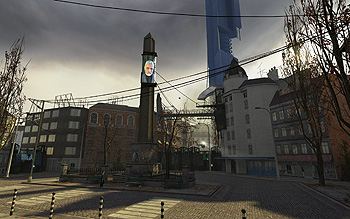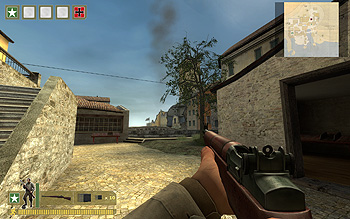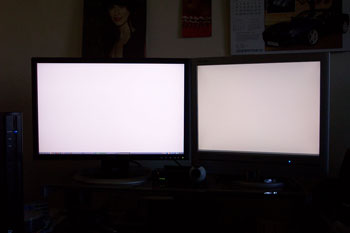Performance
Performance was measured versus the Philips 200P4SS (excellent Super-IPS panel) using cloned DVI outputs from a GeForce 7800 GTX (limiting the Dell to bordered 1600x1200), native resolution testing at 1920x1200 with a GeForce 7800 GTX and some HD video playback using a Radeon X1800 XL at native resolution.The performance evaluation is entirely subjective in advance of a scientific monitor roundup in the coming weeks. These are just my subjective thoughts on how the monitor does, having used it for gaming, video and desktop use in the past couple of weeks.
3D Performance
Gaming on the 2405FPW is great with any number of superlatives also fitting the bill. It's as ghosting free as I can honestly make out in my favourite games, and I get good mileage out of playing at the native resolution or 1680x1050 in a window (windowed is how I usually play) without any issues. Infact, the biggest issue isn't the performance of the panel but the size. I sit far too close when I game and the screen size can often overwhelm my field of vision in a fast moving title. In more pedestrian games I have more time to move my vision around to take everything in.Compared to the Philips they're equals in 3D performance but the Dell is simply much brighter than the Philips has any chance of becoming. Black levels aren't a huge strong point of either panel, compared to a good high-end CRT, but in isolation they're great and I don't find myself willing to adjust contrast to poor IQ levels in darker games just to pick out the details. The Dell's Samsung panel, to my eyes, is as good as the Philips panel in the Philips, for gaming, and it's bigger and brighter to boot.
I'll measure the performance objectively in the monitor roundup, but you'll find it hard to find a gamer that doesn't enjoy doing so on his or her 2405FPW.
2D Performance
Using the digital interface means a pixel perfect display, as expected. There's none of the issues inherent with making an analogue signal look good (especially as you'll find on a CRT) and brightness is your only adjustment, the panel taking care of the rest. In terms of brightness it's a step above the Philips 200P4SS is replaces as my primary display. Here's visual proof.Even at 75% brightness (my working level of luminance) compared to the Philips monitor's 100% level, the Dell is a much brighter display. While brightness is just one facet of a monitor's performance, it plays a large part in overall perception. Brightness is now even across the entire panel; the top left corner was brighter than the rest during the first few days which has since settled down.
If I was to make a complaint here, it's that I sit too close to it and I can see the pixel pitch at times, especially when working with images. That's my own ergonomic fault, though. It's not quite a 'screendoor' effect when sitting close, but it's similar; you can simply see the subpixel groupings.
Video Performance
The Dell 2405FPW obviously works best displaying HDTV resolution video. 1200 scanlines and 16:10 widescreen pixel ratio means that it's got enough display space for all HDTV resolutions right up to 1080p. Indeed, HD video at 1920x1200 (and everything up to that) is viewable over the component input on the 2405FPW.And, yes, it does look fantastic doing HD video. This is 1080p WMV9 HD.
Absolute black performance isn't the best and since there's no contrast control native to the monitor you rely on the graphics card driver to fix up issues you can see, but on the whole the motion performance and vibrancy of the image looks fantastic. It's evident in the picture as you can see.














